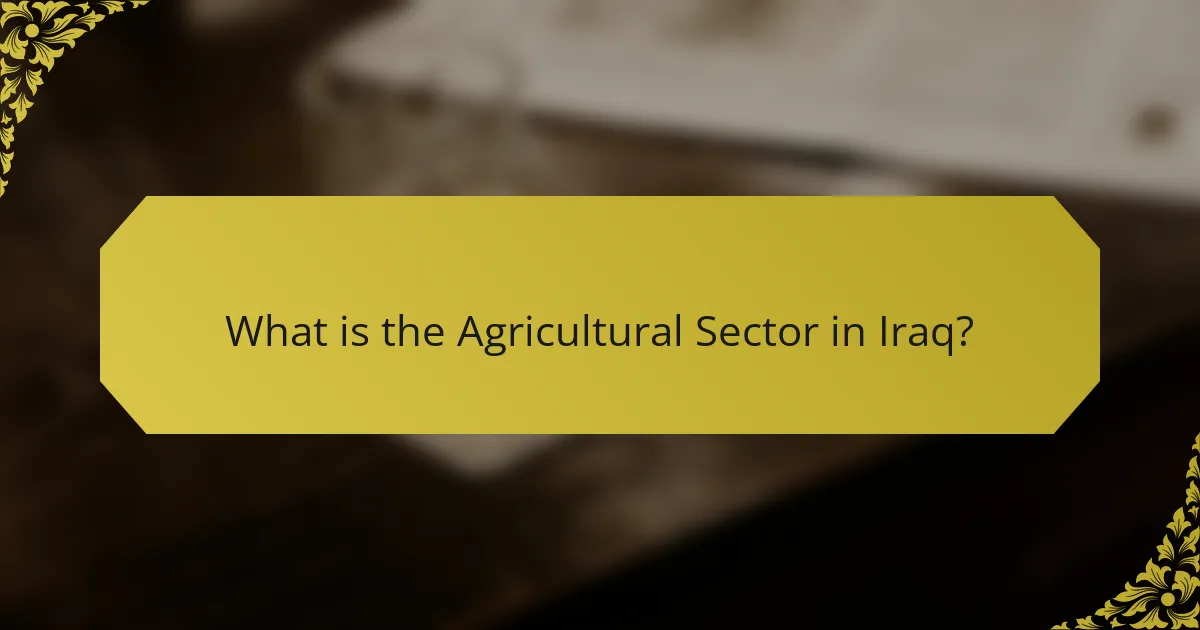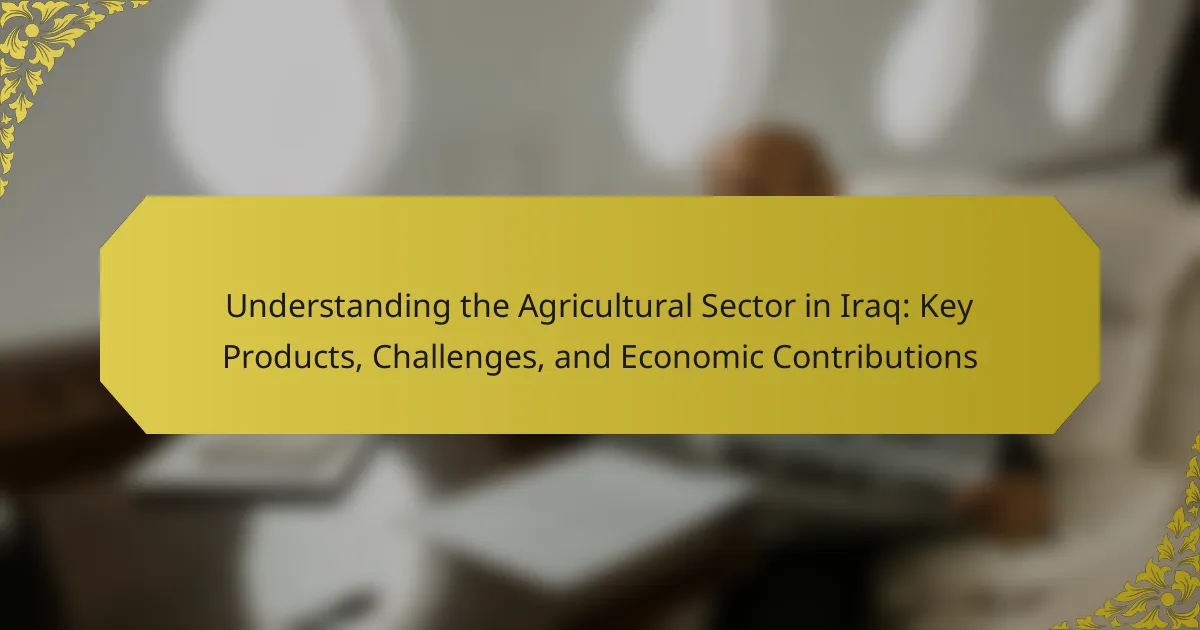
What is the Agricultural Sector in Iraq?
The agricultural sector in Iraq is a vital component of the country’s economy. It encompasses the production of crops, livestock, and fisheries. This sector employs a significant portion of the population, contributing to food security and rural livelihoods. Iraq’s agricultural land primarily consists of the fertile regions between the Tigris and Euphrates rivers. Key crops include wheat, barley, and date palms. The sector faces challenges such as water scarcity, outdated farming techniques, and political instability. Despite these challenges, agriculture remains essential for economic stability and development in Iraq.
How does the agricultural sector contribute to Iraq’s economy?
The agricultural sector significantly contributes to Iraq’s economy by providing employment, food security, and export opportunities. Approximately 20% of Iraq’s workforce is engaged in agriculture. This sector produces essential crops like wheat, barley, and dates. The agricultural output helps ensure food security for the population. Additionally, agriculture contributes to the GDP, accounting for around 5-7%. The sector also supports rural development and livelihoods. Iraq’s diverse climate allows for various agricultural products, enhancing its economic resilience. Overall, the agricultural sector plays a vital role in sustaining Iraq’s economy.
What are the primary economic activities within the agricultural sector?
The primary economic activities within the agricultural sector include crop production, livestock farming, and agro-processing. Crop production involves growing various plants for food, fiber, and fuel. In Iraq, key crops include wheat, barley, and dates. Livestock farming focuses on raising animals for meat, milk, and other products. Common livestock in Iraq includes sheep, goats, and cattle. Agro-processing refers to the transformation of raw agricultural products into consumable goods. This includes activities like milling grains and processing dairy products. These activities significantly contribute to Iraq’s economy, providing employment and food security.
How does agriculture impact employment rates in Iraq?
Agriculture significantly impacts employment rates in Iraq. Approximately 20% of the Iraqi workforce is employed in agriculture. This sector provides livelihoods for many rural families. Agriculture is crucial for food security in the country. The sector faces challenges like water scarcity and outdated farming techniques. Despite these challenges, it remains a vital source of jobs. The government aims to enhance agricultural productivity to boost employment. Investing in modern agricultural practices can further increase job opportunities.
What are the key products of Iraq’s agricultural sector?
The key products of Iraq’s agricultural sector include wheat, barley, rice, and dates. Wheat is the primary staple crop, essential for food security. Barley is also significant for livestock feed and brewing. Rice is cultivated mainly in the southern regions, contributing to local diets. Dates are a vital cash crop, with Iraq being one of the top producers globally. Other important products include fruits and vegetables, particularly tomatoes and citrus fruits. The agricultural sector plays a crucial role in Iraq’s economy, providing employment and supporting rural communities.
Which crops are most commonly produced in Iraq?
Wheat, barley, and rice are the most commonly produced crops in Iraq. Wheat is a staple food and a key part of the Iraqi diet. Barley is primarily used for animal feed and brewing. Rice is also significant, especially in southern regions. The climate and irrigation systems support these crops. Iraq’s agricultural sector has faced challenges, but these crops remain vital for food security.
What livestock is prevalent in Iraq’s agricultural landscape?
Cattle, sheep, and goats are prevalent livestock in Iraq’s agricultural landscape. Cattle are primarily raised for milk and meat production. Sheep are valued for their wool and meat. Goats are also important for milk and meat, particularly in rural areas. Poultry farming is common, providing eggs and meat. The livestock sector contributes significantly to rural livelihoods. According to the Food and Agriculture Organization, livestock supports food security in Iraq.
What challenges does the agricultural sector in Iraq face?
The agricultural sector in Iraq faces multiple challenges. Water scarcity significantly impacts crop production. Iraq’s reliance on the Tigris and Euphrates rivers makes it vulnerable to drought. Soil degradation due to overuse and salinization reduces agricultural productivity. Political instability affects investment and infrastructure development in agriculture. Additionally, outdated farming techniques limit efficiency and yield. Access to markets is often hindered by poor transportation networks. Pest and disease management remains inadequate, threatening crop health. These factors collectively undermine food security in the country.
How do climate conditions affect agricultural productivity in Iraq?
Climate conditions significantly affect agricultural productivity in Iraq. High temperatures and low rainfall create challenging growing conditions. Iraq experiences a hot desert climate, with summer temperatures often exceeding 40°C. This extreme heat can lead to crop stress and reduced yields. Additionally, irregular rainfall patterns result in water scarcity for irrigation. In 2020, drought conditions decreased wheat production by 30% compared to the previous year. Soil salinity, exacerbated by climate change, further limits agricultural output. These factors collectively hinder the agricultural sector’s ability to sustain food security and economic growth in Iraq.
What role do water resources play in the challenges faced by farmers?
Water resources are crucial to the challenges faced by farmers. Insufficient water availability directly impacts crop yields. In Iraq, irregular rainfall and over-extraction of groundwater exacerbate this issue. Farmers often struggle with irrigation due to these limited resources. This leads to reduced agricultural productivity. Furthermore, water scarcity can increase competition among farmers for available supplies. In turn, this competition can drive up costs and create tension within farming communities. Additionally, climate change is projected to worsen water scarcity, further complicating farming efforts. Overall, the role of water resources is central to the agricultural challenges faced by farmers in Iraq.
How does government policy influence the agricultural sector in Iraq?
Government policy significantly influences the agricultural sector in Iraq through regulations, subsidies, and investment initiatives. Policies determine land use, water management, and crop selection. The government provides financial support to farmers, enhancing productivity. Investment in infrastructure, such as irrigation systems, is also driven by policy decisions. Historical context shows that during the 1970s, state policies led to increased agricultural output. However, recent conflicts have disrupted these policies, affecting food security. According to the World Bank, agricultural productivity in Iraq has declined due to inconsistent policy implementation. Overall, government policies are crucial for shaping the agricultural landscape in Iraq.
What initiatives has the Iraqi government implemented to support agriculture?
The Iraqi government has implemented several initiatives to support agriculture. These include providing financial assistance to farmers through loans and subsidies. The government has also invested in irrigation projects to improve water supply for crops. Training programs for farmers have been established to enhance agricultural practices. Additionally, the government has introduced policies to promote the use of modern technology in farming. These initiatives aim to increase agricultural productivity and food security in Iraq.
How do subsidies and regulations affect farmers’ operations?
Subsidies and regulations significantly impact farmers’ operations by influencing their financial stability and production choices. Subsidies can lower production costs, enabling farmers to invest in better technology and practices. For instance, the Iraqi government has provided subsidies for fertilizers and seeds, which can increase crop yields. Regulations, on the other hand, can impose restrictions on farming practices, affecting how farmers operate. Compliance with environmental regulations may require additional investments in sustainable practices. In Iraq, these regulations aim to promote food security and protect natural resources. Overall, the interplay between subsidies and regulations shapes farmers’ economic viability and productivity in the agricultural sector.
What are the future prospects for the agricultural sector in Iraq?
The future prospects for the agricultural sector in Iraq are promising yet challenging. Iraq has significant arable land and a favorable climate for various crops. The government is increasingly focusing on agricultural reforms and investments. These initiatives aim to enhance productivity and reduce dependency on imports.
Iraq’s agricultural sector contributes approximately 5% to the national GDP. It employs about 20% of the workforce. The country has potential in key products like wheat, barley, and date palms. Recent projects have aimed at improving irrigation systems and modernizing farming techniques.
International organizations are also supporting Iraq’s agricultural development. For example, the Food and Agriculture Organization (FAO) has been involved in various programs. These efforts aim to increase food security and sustainable practices in agriculture.
Overall, while challenges such as water scarcity and infrastructure issues persist, the agricultural sector in Iraq is poised for growth through strategic investments and reforms.
What innovations are emerging in Iraq’s agricultural practices?
Emerging innovations in Iraq’s agricultural practices include the adoption of modern irrigation techniques and precision farming. These methods aim to optimize water usage and improve crop yields. Drip irrigation systems are increasingly being implemented to conserve water in arid regions. Additionally, the use of drones for monitoring crop health is gaining traction. These drones provide real-time data on plant conditions and soil health.
Furthermore, Iraqi farmers are beginning to utilize genetically modified organisms (GMOs) to enhance crop resilience. This approach helps in combating pests and diseases more effectively. Training programs are also being introduced to educate farmers on sustainable practices. These innovations are crucial in addressing food security and enhancing agricultural productivity in Iraq.
How can sustainable practices enhance agricultural productivity?
Sustainable practices can enhance agricultural productivity by improving soil health and conserving water. These practices include crop rotation, cover cropping, and reduced chemical use. Crop rotation helps maintain soil fertility and reduce pest pressure. Cover cropping prevents soil erosion and enhances organic matter. Reduced chemical use lowers the risk of soil and water contamination. According to the Food and Agriculture Organization, sustainable practices can increase crop yields by 20-30% in certain regions. Improved water management techniques, such as drip irrigation, can significantly reduce water usage while increasing efficiency. Studies show that farms implementing sustainable practices often see higher profits due to reduced input costs and improved crop quality.
What best practices can farmers adopt to improve agricultural outcomes in Iraq?
Farmers in Iraq can adopt several best practices to improve agricultural outcomes. Implementing crop rotation enhances soil fertility and reduces pest infestations. Utilizing drought-resistant crop varieties helps in adapting to water scarcity. Efficient irrigation techniques, such as drip irrigation, conserve water and improve yield. Integrated pest management reduces reliance on chemical pesticides. Soil testing before planting ensures the right nutrients are applied. Training programs on modern farming techniques can enhance knowledge and skills. Collaborating with agricultural cooperatives can provide access to resources and markets. These practices are vital for increasing productivity and sustainability in Iraq’s agricultural sector.
The agricultural sector in Iraq is a crucial part of the country’s economy, encompassing crop production, livestock farming, and fisheries. This sector employs approximately 20% of the workforce and contributes around 5-7% to the national GDP, with key products including wheat, barley, rice, and dates. However, Iraq’s agriculture faces significant challenges such as water scarcity, outdated farming techniques, and political instability. The article will explore these economic contributions, key products, and the various challenges impacting agricultural productivity, while also highlighting government initiatives and emerging innovations aimed at enhancing the sector’s sustainability and growth.


